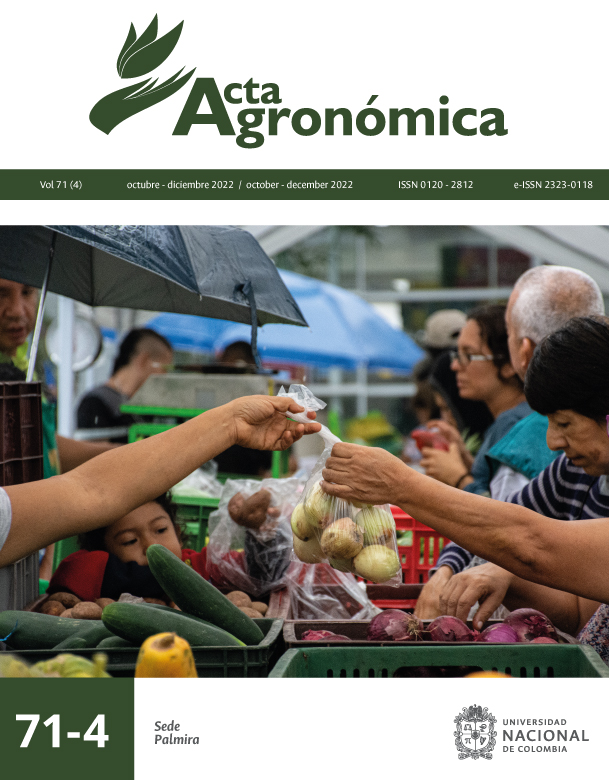Análisis de estabilidad de biochar de residuos agroforestales
Stability analysis of biochar from agroforestry pruning
DOI:
https://doi.org/10.15446/acag.v71n4.94948Keywords:
Biomasa, energías limpias, enmienda, pirólisis, reactividad (es)Biomass, Clean energy, amendment, pyrolysis, reactivity (en)
Downloads
La pirólisis es un proceso de descomposición térmica en el que se obtiene biochar, que es un componente enriquecido en carbono. La diferencia entre el carbono vegetal y el biochar es que este es exclusivamente una enmienda de suelo y permite el manejo de residuos sólidos lignocelulósicos. Asimismo, el biochar es considerado una alternativa para fijar carbono de la atmósfera en el suelo; por ello, esta investigación evaluó la estabilidad del biochar obtenido a través de la pirólisis a 300 °C y 500 °C de los residuos de podas de las cinco especies forestales de mayor abundancia en la Universidad Nacional Agraria La Molina (UNALM), Lima, Perú. La investigación evaluó la estabilidad del biochar en función al grado de estabilidad y la prueba estandarizada de AT4. Respecto al grado de estabilidad, este se incrementa al elevarse la temperatura de pirólisis de 300°C a 500°C en una razón de 0.102, asimismo, el carbono lábil disminuye en 5.21 %, el carbono oxidable en 13.66 %, mientras que el carbono recalcitrante se incrementa en 10.90 %. En cuanto a la prueba respirométrica, se observó un comportamiento similar, dado que se encontró mayor descomposición en el carbono que tendría menor grado de estabilidad, variando el índice AT4 en 2.74. Respecto a las especies, de acuerdo con el grado de estabilidad y AT4, el más estable fue el biochar de Molle a 500 °C.
Pyrolysis is a thermal decomposition process through which biochar is obtained, which is a component enriched in carbon. The difference between vegetal carbon and biochar is that the latter is exclusively a soil amendment that allows the management of lignocellulosic wastes. Likewise, biochar is considered an alternative to fix carbon from the atmosphere in the soil. This research evaluated the stability of biochar obtained through pyrolysis at 300 °C and 500 °C from the pruning waste of the five most abundant forest species from the National Agrarian University – La Molina (UNALM), Lima, Perú. This investigation evaluated the stability of the biochar based on the degree of stability and the standardized AT4 test. Regarding the degree of stability, it increased in a ratio of 0.102 when the pyrolysis temperature raised from 300 °C to 500 °C, likewise, the labile carbon decreased by 5.21 %, the oxidizable carbon by 13.66 %, while the recalcitrant carbon increased by 10.90 %. Regarding the spirometry test, a similar behavior was observed, since greater decomposition in the carbon that would have a lower degree of stability was noticed, varying the AT4 index by 2.74. Regarding the species, according to the degree of stability and the AT4, the most stable biochar was that of Molle 500 °C.
References
Aller, D.; Bakshi, S. y Laird, D. (2017). Modified method for proximate analysis of biochars, Journal of Analytical and Applied Pyrolysis, 124, 335-342. https://doi.org/10.1016/j.jaap.2017.01.012 DOI: https://doi.org/10.1016/j.jaap.2017.01.012
Brassard, P.; Godbout, S. y Raghavan, V. (2016). Soil biochar amendment as a climate change mitigation tool: Key parameters and mechanisms involved, Journal of Environmental Management, 181, 484-497. https://doi.org/10.1016/j.jenvman.2016.06.063 DOI: https://doi.org/10.1016/j.jenvman.2016.06.063
Brown, D.; Hughes, C.; Spence, M.; Bonte, M. y Whale, G. (2018) Assessing the suitability of a monometric test system for determining the biodegradability of volatile hydrocarbons, Chemosphere, 195, 381-389. https://doi.org/10.1016/j.chemosphere.2017.11.169 DOI: https://doi.org/10.1016/j.chemosphere.2017.11.169
Chen, D. Chen, Yu, X.; Song, C.; Pang, X.; Huang, J,; Li,Y. (2016). Effect of pyrolysis temperature on the chemical oxidation stability of bamboo biochar, Bio resource Technology. Vol. 218, pp. 1303 – 1306 DOI: https://doi.org/10.1016/j.biortech.2016.07.112
Cheng, J.; Hu, S.; Sun, G.; Geng, Z. y Zhu, M. (2021). The effect of pyrolysis temperature on characteristics of biochar, pyroligneous acids, and gas prepared from cotton stalk through a polygeneration process, Industrial Crops and Products, 170, 113690, https://doi.org/10.1016/j.indcrop.2021.113690 DOI: https://doi.org/10.1016/j.indcrop.2021.113690
Das, S. K.; Ghosh, G. K.; Avasthe, R. K. y Kundu, M. Ch. (2018). Preparation and characterization of biochars for their application as a soil amendment, Indian Journal of Hill Farming, 31(1), 141-145. https://www.researchgate.net/publication/326589014_Preparation_and_Characterization_of_Biochars_for_their_Application_as_a_Soil_Amendment
Heidari, A.; Khaki, E.; Younesi, H. y Lu, H. (2019). Evaluation of fast and slow pyrolysis methods for bio-oil and activated carbon production eucalyptus wastes using a life cycle assesment approach, Journal of Cleaner Production, 214, 118394. https://doi.org/10.1016/j.jclepro.2019.118394 DOI: https://doi.org/10.1016/j.jclepro.2019.118394
IBI (International Biochar Iniative). (2015). Standardized product definition and product testing guidelines for biochar that is used in soil. https://biochar-international.org/wp-content/uploads/2020/06/IBI_Biochar_Standards_V2.1_Final2.pdf
Keiluweit, M.; Nico, P. S.; Johnson, M.G. y Kleber, M. J. E. S. (2010). Dynamic molecular structure of plant biomass-derived black carbon (biochar), Environmental Science and Technology, 44(4), 1247-1253. https://pubs.acs.org/doi/pdf/10.1021/es9031419 DOI: https://doi.org/10.1021/es9031419
La República. (2017). Multan a Universidad Agraria con S/2.4 millones por incendio que duró 6 horas. http://larepublica.pe/sociedad/860370-multan-universidad-agraria-con-s24-millones-por-incendio-que-duro-6-horas
LECO Corporation. (2013). Carbon, hydrogen, and nitrogen in coal, instrument: CHN628.https://eu.leco.com/images/Analytical-Application-Library/CHN628_COAL_203-821-403.pdf
Lehmann, J. y Joseph, S. (Eds.). (2009). Biochar for environmental management, Science and technology. Londres: Earhscan. http://www.css.cornell.edu/faculty/lehmann/publ/First%20proof%2013-01-09.pdf
Li, S. y Chen, G. (2018). Thermogravimetric, thermochemical, and infrared spectral characterization off feedstocks and biochar derives at different pyrolysis temperature, Waste Management, 78, 198-207. https://doi.org/10.1016/j.wasman.2018.05.048 DOI: https://doi.org/10.1016/j.wasman.2018.05.048
Li, C.; Sun, Y.; Zhang, S.; Wang, Y.; Xiang, J.; Hu, S.; Wang, S. y Hu, H. (2021). Pyrolysis of sesame residue: Evolution of the volatiles and structures of biochar versus temperature, Environmental Technology & Innovation, 24, 101859. https://doi.org/10.1016/j.eti.2021.101859 DOI: https://doi.org/10.1016/j.eti.2021.101859
López, M.; Huerta-Pujol, O.; Martínez-Farré; F. X. y Soliva, M. (2010). Approaching compost stability from Klason lignin modified method: Chemical stability degree for OM and N quality assessment. Resources, Conservation and Recycling, 55(2), 171-181. https://upcommons.upc.edu/bitstream/handle/2117/11181/SD%20pre-print.pdf;jsessionid=26A9F8C3A611517FCC2D82C770B9BFEB?sequence=1 DOI: https://doi.org/10.1016/j.resconrec.2010.09.005
Machado, C.; Raman, V.; Tehman, J.; Maia, B.; Meneghetti, E.; Almeida, V.; Farago, P.; Khan, I. y Budel, J. (2019). Schinus molle: Anatomy of leaves and stems, chemical composition and insecticidal activities of volatile oil against bed bug (Cimex lectularius), Revista Brasileira de Farmacognosia, 29, 1-10. https://www.scielo.br/scielo.php?script=sci_arttext&pid=S0102-695X2019000100001 DOI: https://doi.org/10.1016/j.bjp.2018.10.005
Noegi, S.; Sharma, V.; Khan, N.; Chaurasia, D.; Ahmad, A.; Chauhan, S.; Singh, A.; You, S.; Pandey, A. y Bhargava, P. (2022). Sustainable biochar: A facile strategy for soil and environmental restoration, energy generation, mitigation of global climate change and circular bioeconomy, Chemosphere, 293, 133474. https://doi.org/10.1016/j.chemosphere.2021.133474 DOI: https://doi.org/10.1016/j.chemosphere.2021.133474
Ospina-Guarín, V.; Buitrago-Sierra, R. y López-López, D. P. (2014). Preparación y caracterización de carbón activado a partir de torta de higuerilla, TecnoLógicas, 17,(32), 75-84. http://www.scielo.org.co/scielo.php?script=sci_arttext&pid=S0123-77992014000100008 DOI: https://doi.org/10.22430/22565337.207
Palacios, R. (2020). Estabilidad y calidad de biochar de residuos agroforestales de la UNALM [tesis de pregrado]. Universidad Nacional Agraria la Molina. https://repositorio.lamolina.edu.pe/bitstream/handle/20.500.12996/4380/palacios-hugo-rosario-natividad.pdf?sequence=1&isAllowed=y
Pérez-Arévalo, J. y Velázquez-Martí, B. (2018). Evaluation of pruning residues of Ficus benjamina as a primary biofuel material, Biomass and Bioenergy, 108, 217-223. https://www.sciencedirect.com/science/article/abs/pii/S0961953417303926 DOI: https://doi.org/10.1016/j.biombioe.2017.11.017
Six, J.; Conant, R. T.; Paul, E. A. y Paustian, K. (2002). Stabilization mechanisms of soil organic matter: Implications for C-saturation of soils, Plant and Soil, 241, 155-176. https://www.nrel.colostate.edu/assets/nrel_files/labs/paul-lab/docs/Six_PltSoil2002.pdf DOI: https://doi.org/10.1023/A:1016125726789
Suárez-Abelenda, M.; Kaal, J. y McBeath, A. V. (2017). Translating analytical pyrolysis fingerprints to Thermal Stability Indices (TSI) to improve biochar characterization by pyrolysis-GC-MS, Biomass and Bioenergy, 98, 306-320. https://www.sciencedirect.com/science/article/abs/pii/S0961953417300387?via%3Dihub DOI: https://doi.org/10.1016/j.biombioe.2017.01.021
Van Zwieten, L.; Kimber, S.; Morris, S.; Chan, K. Y.; Downie, A.; Rust, J.; Joseph, S. y Cowie, A. (2010). Appendix C-Effects of biochar from slow pyrolysis of papermill waste on agronomic performance and soil fertility. In Biochar production and use: Environmental risks and rewards. Adriana Downie-PhD Thesis. DOI: https://doi.org/10.1007/s11104-009-0050-x
Wang, J.; Xiong, Z. y Kuzyakov, Y. (2016). Biochar stability in soil: Meta-analysis of decomposition and priming effects, GCB Bioenergy, 8, 512-523. https://onlinelibrary.wiley.com/doi/epdf/10.1111/gcbb.12266 DOI: https://doi.org/10.1111/gcbb.12266
Wang, S.; Zhang, H.; Huang, H.; Xiao, R.; Li, R. y Zhang, Z. (2020). Influence of temperature and residence time on characteristics of biochar derived from agricultural residues: A comprehensive evaluation, Process Safety and Environmental Protection, 139, 218-229. https://doi.org/10.1016/j.psep.2020.03.028 DOI: https://doi.org/10.1016/j.psep.2020.03.028
Zhang, P.; Huang, P.; Xu, X.; Sun, H.; Jiang, B. y Liao, Y. (2019). Spectroscopic and molecular characterization of biochar-derived dissolved organic matter and the associations with soil microbial responses, Science of the Total Environment, 708, 134619. https://doi.org/10.1016/j.scitotenv.2019.134619 DOI: https://doi.org/10.1016/j.scitotenv.2019.134619
Zhang, C.; Zhang, Z.; Zhang, L.; Li, Q.; Li, C.; Chen, G.; Zhang, S.; Liu, Q. y Hu, X. (2020). Evolution of the functionalities and structures of biochar in pyrolysis of poplar in a wide temperature range, Bioresource Technology, 304, 123002. https://doi.org/10.1016/j.biortech.2020.123002 DOI: https://doi.org/10.1016/j.biortech.2020.123002
How to Cite
APA
ACM
ACS
ABNT
Chicago
Harvard
IEEE
MLA
Turabian
Vancouver
Download Citation
License

This work is licensed under a Creative Commons Attribution-NonCommercial-NoDerivatives 4.0 International License.
Política sobre Derechos de autor:Los autores que publican en la revista se acogen al código de licencia creative commons 4.0 de atribución, no comercial, sin derivados.
Es decir, que aún siendo la Revista Acta Agronómica de acceso libre, los usuarios pueden descargar la información contenida en ella, pero deben darle atribución o reconocimiento de propiedad intelectual, deben usarlo tal como está, sin derivación alguna y no debe ser usado con fines comerciales.






 >
> >
>



















